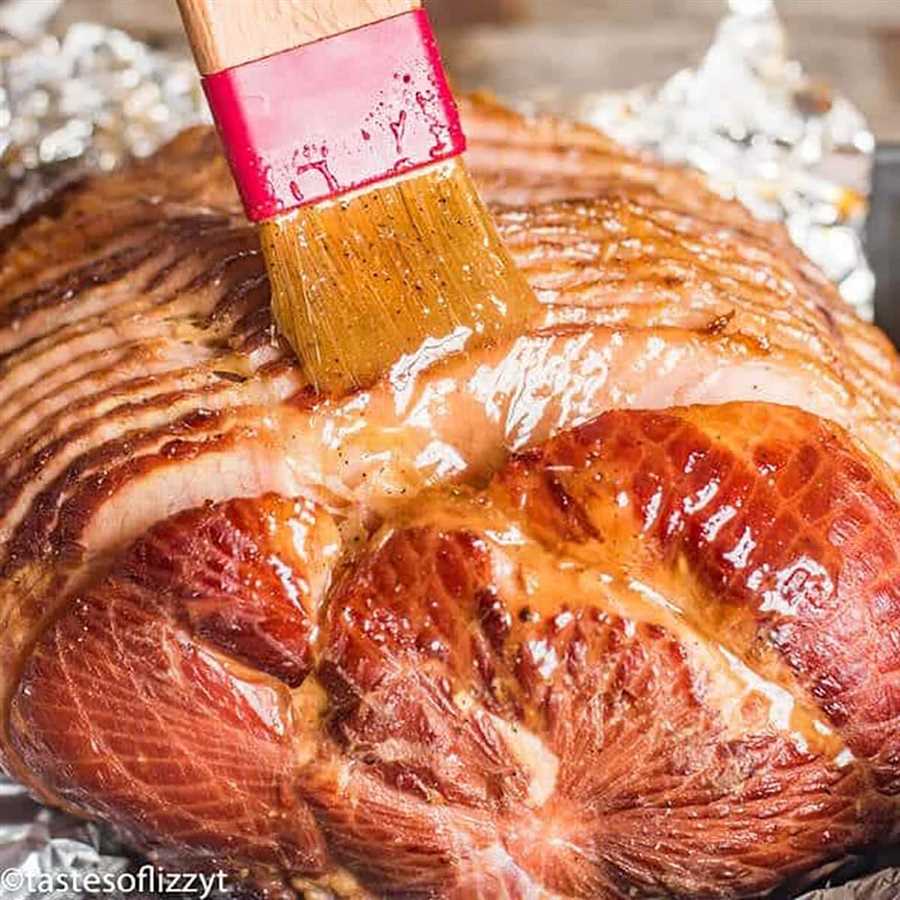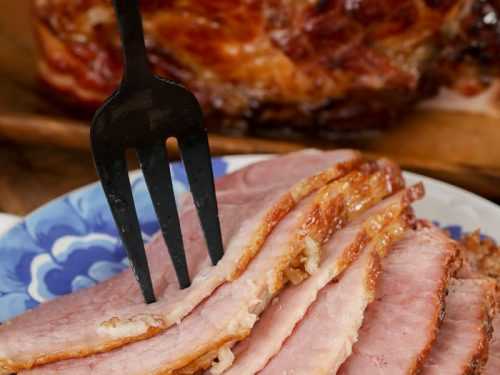If you have ever wondered whether you can cook a ham in a roasting pan, the answer is yes! Many home cooks use roasting pans for cooking their hams. A roasting pan is a versatile and convenient cooking tool that can be used for a variety of dishes, including hams.
When cooking a ham in a roasting pan, it is important to choose the right type of ham and to follow the proper cooking instructions. A roasting pan provides a large and deep cooking surface, allowing the heat to circulate evenly around the ham. This helps to ensure that the ham cooks evenly and retains its moisture and tenderness.
Before placing the ham in the roasting pan, it is a good idea to score the ham’s surface with a sharp knife. This will allow the glaze or seasoning to penetrate the meat and enhance its flavor. To prevent the ham from drying out, you can also baste it with a glaze or a cooking liquid during the cooking process. This will help to keep the ham moist and flavorful.
Overall, cooking a ham in a roasting pan is a great choice for anyone looking to make a delicious and tender ham. With the right technique and a few simple ingredients, you can create a mouthwatering ham that will be the highlight of your meal. So go ahead, grab your roasting pan and start cooking that ham!
How to Cook a Ham in a Roasting Pan
If you’re looking to cook a delicious ham for a special occasion, using a roasting pan can be a great option. The roasting pan allows for even cooking and helps to keep the ham moist and flavorful. Here’s a step-by-step guide on how to cook a ham in a roasting pan:
- Preheat your oven to the recommended temperature for your ham.
- Remove the ham from its packaging and place it in the roasting pan.
- Add any desired seasonings or glazes to the ham. You can use a combination of herbs, spices, sauces, or brown sugar to enhance the flavor.
- Cover the roasting pan with a lid or aluminum foil to keep the ham moist during cooking.
- Place the roasting pan with the ham in the preheated oven.
- Cook the ham according to the recommended cooking time based on its weight. Generally, you’ll want to cook the ham for about 18 to 20 minutes per pound.
- Using a meat thermometer, check the internal temperature of the ham. It should reach a minimum of 145°F (63°C) for safe consumption.
- If desired, you can baste the ham with its juices or glaze during the last 30 minutes of cooking to add extra flavor.
- Once the ham reaches the desired temperature, remove it from the oven and let it rest for a few minutes before carving.
Now you’re ready to serve a deliciously cooked ham that will impress your family and friends!
Choosing the Right Ham
When it comes to cooking a delicious ham in a roasting pan, selecting the right cut of meat is crucial. There are several factors to consider when choosing a ham for roasting, including the type of ham, the size, and whether it is bone-in or boneless.
First, you’ll want to decide on the type of ham you prefer. There are different types available, such as smoked, cured, or uncooked. Smoked hams have a distinct and rich flavor, while cured hams are saltier and have been preserved with salt and other seasonings. On the other hand, uncooked hams allow you to add your own flavors and seasonings.
Once you’ve decided on the type of ham, consider the size that will best suit your needs. Hams typically range in size from 4 to 20 pounds or more. If you’re cooking for a smaller group, a smaller ham will be sufficient. However, if you’re planning a large gathering or want leftovers, a larger ham will be necessary.
Another important factor to consider is whether you want a bone-in or boneless ham. Bone-in hams are generally more flavorful and tender, but they can be a bit trickier to carve. On the other hand, boneless hams are easier to slice and serve, but they may not have as much flavor.
To help you make an informed decision, here’s a comparison table of the different types of hams:
| Type of Ham | Flavor | Texture | Ease of Carving |
|---|---|---|---|
| Smoked | Distinct and rich | Tender | Slightly trickier |
| Cured | Salty and seasoned | Tender | Slightly trickier |
| Uncooked | Customizable | Tender | Slightly trickier |
Keep in mind that regardless of the type of ham you choose, it’s important to properly cook and glaze it to enhance its flavors. Whether you’re roasting a smoked, cured, or uncooked ham, a roasting pan is an excellent choice to achieve the best results.
Preparing the Ham
Before you cook your ham in a roasting pan, it’s important to properly prepare it. Here are the steps you need to follow:
Gather Your Ingredients
First, gather all the ingredients you’ll need for seasoning and basting your ham. This may include brown sugar, honey, mustard, cloves, or any other spices or glazes you prefer.
Trim the Ham
Next, trim any excess fat from the ham, leaving about a quarter-inch layer for added flavor and moistness.
Score the Ham
Using a sharp knife, score the surface of the ham in a diamond pattern. This will help the glaze penetrate and infuse the meat with flavor.
Season the Ham

Apply your desired seasonings to the ham, rubbing them into the scored surface. You can use a dry rub or a glaze, depending on your preference.
Marinate the Ham (optional)

If you have time, marinating the ham can enhance its flavor. Place the seasoned ham in a plastic bag or covered dish and let it marinate in the refrigerator for a few hours or overnight.
By following these steps, you’ll be well on your way to preparing a delicious ham that’s ready to be cooked in a roasting pan!
Seasoning and Flavors
When cooking a ham in a roasting pan, seasoning it properly is crucial to enhancing its flavors. Here are some popular seasonings and flavor combinations that you can try:
- Classic Ham Glaze: Made with a combination of brown sugar, mustard, and cloves, this glaze adds a sweet and tangy flavor to the ham.
- Honey and Pineapple Glaze: A delicious combination of honey, pineapple juice, and Dijon mustard creates a sweet and tropical flavor profile.
- Maple and Dijon Glaze: This glaze uses a mixture of maple syrup, Dijon mustard, and cloves for a rich and slightly spicy taste.
- Orange and Cranberry Glaze: The tanginess of orange juice and the tartness of cranberries create a vibrant and refreshing flavor.
In addition to glazes, you can also season the ham with herbs and spices. Some popular options include:
- Garlic and Rosemary: Rub the ham with minced garlic and fresh rosemary for a savory and aromatic flavor.
- Thyme and Sage: Sprinkle dried thyme and sage over the ham to add earthy and herby notes.
- Smoked Paprika and Cumin: For a smoky and slightly spicy flavor, coat the ham with a mixture of smoked paprika and cumin.
Remember to baste the ham with its glaze or juices periodically during cooking to ensure the flavors penetrate the meat. Experiment with different combinations to find your favorite flavor profile!
Cooking Techniques
When it comes to cooking a ham in a roasting pan, there are several techniques you can use to ensure a delicious and flavorful result.
1. Preparing the Ham:
Before cooking the ham, it is important to prepare it properly. Start by removing the packaging and any netting or strings that may be holding the ham together. If the ham has a thick layer of fat, you can score it with a sharp knife to help render the fat during cooking.
2. Seasoning the Ham:
Seasoning the ham will add flavor and enhance its taste. You can use a variety of seasonings such as salt, pepper, garlic powder, paprika, or herbs like thyme or rosemary. Rub the seasoning mixture over the entire surface of the ham for an even flavor distribution.
3. Cooking the Ham:
| Technique | Description |
| Baking | Place the seasoned ham in a roasting pan and bake it in a preheated oven according to the package instructions. This method allows the heat to circulate evenly around the ham, resulting in a tender and moist end product. |
| Glazing | If you prefer a glazed ham, you can apply a glaze during the last 20-30 minutes of cooking. A glaze can be made using ingredients like brown sugar, honey, mustard, or pineapple juice. Brush the glaze over the ham and continue baking until it becomes sticky and caramelized. |
| Slow Cooking | Another technique you can use is slow cooking the ham. This involves cooking the ham at a lower temperature for a longer period of time. Slow cooking allows the flavors to develop and the meat to become tender and juicy. |
4. Checking the Temperature:
It is essential to check the internal temperature of the ham using a meat thermometer to ensure it is fully cooked. The ham should reach an internal temperature of 145°F (63°C) for safe consumption. Insert the thermometer into the thickest part of the ham, avoiding any bones.
5. Resting and Slicing:
After cooking the ham, allow it to rest for about 10-15 minutes before slicing. This allows the juices to redistribute throughout the meat, ensuring a moist and flavorful result. Slice the ham thinly against the grain for the best texture.
By following these cooking techniques, you can cook a ham in a roasting pan to perfection, creating a mouthwatering centerpiece for any meal.
Questions and answers
Can I cook a ham in a roasting pan?
Yes, you can cook a ham in a roasting pan. It is a common method of cooking ham.
What is the benefit of cooking a ham in a roasting pan?
The benefit of cooking a ham in a roasting pan is that it allows the ham to cook evenly and creates a juicy and flavorful result.
How do you cook a ham in a roasting pan?
To cook a ham in a roasting pan, preheat your oven to the recommended temperature. Place the ham in the roasting pan, add any desired seasonings or glaze, and cover the pan with foil. Cook the ham in the oven for the recommended time, periodically basting it with the pan juices.
What temperature should a ham be cooked in a roasting pan?
The temperature at which a ham should be cooked in a roasting pan varies depending on the type and size of the ham. It is best to refer to the specific cooking instructions provided by the manufacturer or a reliable recipe source.
Can I use a roasting pan with a lid to cook a ham?
Yes, you can use a roasting pan with a lid to cook a ham. The lid helps to keep the moisture in and ensures that the ham stays tender and juicy.
Can I cook a ham in a roasting pan?
Yes, you can cook a ham in a roasting pan. It is a common method of cooking ham because the roasting pan allows for even heat distribution and helps to keep the ham moist during cooking.






